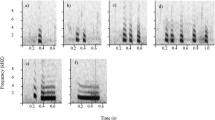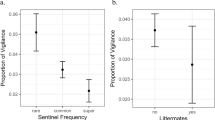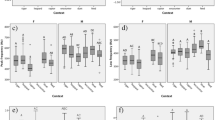Abstract
Socio-demographic factors, such as group size and their effect on predation vulnerability, have, in addition to intrinsic factors, dominated as explanations when attempting to understand animal vigilance behaviour. It is generally assumed that animals evaluate these external factors visually; however, many socially foraging species adopt a foraging technique that directly compromises the visual system. In these instances, such species may instead rely more on the acoustical medium to assess their relative risk and guide their subsequent anti-predator behaviour. We addressed this question in the socially foraging meerkat (Suricata suricatta). Meerkats forage with their head down, but at the same time frequently produce close calls (‘Foraging’ close calls). Close calls are also produced just after an individual has briefly scanned the surrounding environment for predators (‘Guarding’ close calls). Here, we firstly show that these Guarding and Foraging close call variants are in fact acoustically distinct and secondly subjects are less vigilant (in terms of frequency and time) when exposed to Guarding close call playbacks than when they hear Foraging close calls. We argue that this is the first evidence for socially foraging animals using the information encoded within calls, the main adaptive function of which is unrelated to immediate predator encounters, to coordinate their vigilance behaviour. In addition, these results provide new insights into the potential cognitive mechanisms underlying anti-predator behaviour and suggest meerkats may be capable of signalling to group members the ‘absence’ of predatory threat. If we are to fully understand the complexities underlying the coordination of animal anti-predator behaviour, we encourage future studies to take these additional auditory and cognitive dimensions into account.


Similar content being viewed by others
References
Allison PD (1999) Multiple regression: a primer. Pine Forge, Thousand Oaks
Bednekoff PA, Bowman R, Woolfenden GE (2008) Do conversational gutturals help Florida scrub-jays coordinate their sentinel behavior? Ethology 114:313–317
Bell MBV, Radford AN, Rose R, Wade H, Ridley AR (2009) The value of constant surveillance in a risky environment. Proc R Soc B 276:2997–3005
Bell MBV, Radford AN, Smith RA, Thompson AM, Ridley AR (2010) Bargaining babblers: vocal negotiation of cooperative behaviour in a social bird. Proc R Soc B 277:3223–3228
Blumstein DT, Daniel JC, McLean IG (2001) Group size effects in quokkas. Aust J Zool 49:641–649
Bugnyar T, Kijne M, Kotrschal K (2001) Food calling in ravens: are yells referential signals? Anim Behav 61:949–958
Burkart JM, van Schaik CP (2010) Cognitive consequences of cooperative breeding in primates? Anim Cogn 13(1):1–19
Carter AJ, Pays O, Goldizen AW (2009) Individual variation in the relationship between vigilance and group size in eastern grey kangaroos. Behav Ecol Sociobiol 64:237–245
Charlton BD, Zhang Z, Snyder RJ (2010) Giant pandas perceive and attend to formant frequency variation in male bleats. Anim Behav 79:1221–1227
Cheney DL, Seyfarth RM (1990) How monkeys see the world. University of Chicago Press, Chicago
Clutton-Brock TH, Gaynor D, Kansky R, MacColl ADC, McIlrath G, Chadwick P, Brotherton PNM, O’Riain JM, Manser M, Skinner JD (1998) Costs of cooperative behaviour in suricates (Suricata suricatta). Proc R Soc B 265:185–190
Clutton-Brock TH, O’Riain MJ, Brotherton PNM, Gaynor D, Kansky R, Griffin AS, Manser M (1999) Selfish sentinels in cooperative mammals. Science 284:1640–1644
Crawley MJ (2002) Statistical computing: an introduction to data analysis using S-Plus. Wiley, Chichester
Evans CS, Evans L (2007) Representational signaling in birds. Biol Lett 2007(3):8–11
Evans CS, Evans L, Marler P (1993) On the meaning of alarm calls: functional reference in an avian vocal system. Anim Behav 46:23–38
Faraway JJ (2006) Linear models with R. Chapman & Hall/CRC, Boca Raton
Fernandez-Juricic E, Erichsen JT, Kacelnik A (2004) Visual perception and social foraging in birds. Trends Ecol Evol 19:25–31
Gallistel CR (1990) The organization of learning. MIT Press, Cambridge
Gouzoules S, Gouzoules H, Marler P (1984) Rhesus monkey (Macaca mulatta) screams: representational signalling in the recruitment of agonistic aid. Anim Behav 32:182–193
Hauser MD (1996) The evolution of communication. MIT Press, Cambridge
Hollen LI, Bell MBV, Radford AN (2008) Cooperative sentinel calling? Foragers gain increased biomass intake. Curr Biol 18:576–579
Hunter TB, Skinner JD (1998) Vigilance behavior in African ungulates: the role of predation pressure. Behaviour 135:195–211
Jennings T, Evans SM (1980) Influence of position in the flock and flock size on vigilance in the starling, Sturnus vulgaris. Anim Behav 28:634–635
Krause J, Ruxton GD (2002) Living in groups. Oxford University Press, Oxford
Lima SL, Bednekoff PA (1999) Back to basics of antipredatory vigilance: can nonvigilant animals detect attack? Anim Behav 58:537–543
Macedonia JM, Evans CS (1993) Variation among mammalian alarm call systems and the problem of meaning in animal signals. Ethology 93:177–197
Manser MB (1998) The evolution of auditory communication in suricates (Suricata suricatta). Ph.D. thesis, University of Cambridge
Manser MB (1999) Response of foraging group members to sentinel calls in suricates, Suricata suricatta. Proc R Soc B 266:1013–1019
Manser MB (2001) The acoustic structure of suricates’ alarm calls varies with predator type and the level of response urgency. Proc R Soc B 268:2315–2324
Manser MB, Bell MB, Fletcher LB (2001) The information that receivers extract from alarm calls in suricates. Proc R Soc B 268:2485–2491
Mundry R, Sommer C (2007) Discriminant function analysis with nonindependent data: consequences and an alternative. Anim Behav 74:965–976
Palombit RA, Cheney DL, Seyfarth RM (1999) Male grunts as mediators of social interaction with females in wild chacma baboons (Papio cynocephalus ursinus). Behaviour 136:221–242
Pulliam HR (1973) On the advantages of flocking. J Theor Biol 38:419–422
Radford AN (2004) Vocal mediation of foraging competition in the cooperatively breeding green woodhoopoe, Phoeniculus purpureus. Behav Ecol Sociobiol 56:279–285
Radford AN, Ridley AR (2007) Individuals in foraging groups may use vocal cues when assessing their need for antipredator vigilance. Biol Lett 3:249–252
Rasa OAE (1986) Coordinated vigilance in dwarf mongoose family groups: the ‘watchman song’ hypothesis and the costs of guarding. Ethology 71:340–344
Rice WR (1989) Analyzing tables of statistical tests. Evolution 43:223–225
Ridley AR, Raihani NJ (2008) Task partitioning increases reproductive output in cooperative bird. Behav Ecol 19:1136–1142
Schel AM, Candiotti A, Zuberbühler K (2010) Predator-deterring alarm call sequences in Guereza colobus monkeys are meaningful to conspecifics. Anim Behav 80:799–808
Schibler F, Manser MB (2007) The irrelevance of individual discrimination in meerkat alarm calls. Anim Behav 74:1259–1268
Seyfarth RM, Cheney DL, Marler P (1980) Vervet monkey alarm calls: semantic communication in a free-ranging primate. Anim Behav 28:1070–1094
Seyfarth RM, Cheney DL, Bergman T, Fischer J, Zuberbuhler K, Hammerschmidt K (2010) The central importance of information in studies of animal communication. Anim Behav 80(1):3–8
Shannon C (1948) A mathematical theory of communication. Bell Syst Tech J 27(379–423):623–656
Slocombe KE, Townsend SW, Zuberbuhler K (2009) Wild chimpanzees distinguish between different scream types: evidence from a playback study. Anim Cogn 12(3):441–449
Snowdon CT, Elowson AM (2001) ‘Babbling’ in pygmy marmosets: development after infancy. Behaviour 138:1235–1248
Sullivan KA (1984) Information exploitation by downy woodpeckers in mixed-species flocks. Behaviour 91:294–311
Townsend SW, Manser MB (2011) The function of non-linear phenomena in meerkat alarm calls. Biol Lett 7:47–49
Townsend SW, Hollen LI, Manser MB (2010) Meerkat close calls encode group-specific signatures but receivers fail to discriminate. Anim Behav 80:133–138
Uster D, Zuberbuhler K (2001) The functional significance of Diana monkey ‘clear calls’. Behaviour 138:741–756
Valone TJ (2007) From eavesdropping on performance to copying the behaviour of others: a review of public information use. Behav Ecol Sociobiol 62:1–14
Weiner N (1961) Cybernetics; or control and communication in the animal and the machine. MIT Press, New York
Wickler W (1985) Coordination of vigilance in bird groups: the “watchman’s song” hypothesis. Z Tierpsychol 69:250–253
Zuberbuhler K (2000) Referential labeling in Diana monkeys. Anim Behav 59:917–927
Acknowledgements
We would like to thank Tim Clutton-Brock for his support to work on the meerkat population of the Kalahari Meerkat Project and the owners of farms surrounding the reserve for allowing us to work on their land. We are thankful to Megan Price and Christele Borgeaud, as field managers, and the volunteers of the project for their help over the duration of the study. Thanks to Micheal Owren for Praat scripts, Roger Mundry for statistical support and for providing pDFA scripts, Katie Slocombe, Beke Graw, David Jansen and Manuela Cadilek for discussions and Amanda Ridley, Peter Bednekoff and two anonymous reviewers for helpful comments on the manuscript. The study was carried out under licenses issued by the Northern Cape Conservation Service and ethical committee of Pretoria University, South Africa. This work was funded by the University of Zurich.
Author information
Authors and Affiliations
Corresponding author
Additional information
Communicated by P. Bednekoff
Electronic supplementary material
Below is the link to the electronic supplementary material.
ESM 1
Time frequency spectrogram and accompanying waveform showing two distinct tonal meerkat sentinel calls. Spectrogram window settings: FFT length = 512, Hamming window, window length = 0.05 s, bandwidth = 112 Hz, frequency resolution = 86 Hz, dynamic range = 70 dB. (DOC 45 kb)
Rights and permissions
About this article
Cite this article
Townsend, S.W., Zöttl, M. & Manser, M.B. All clear? Meerkats attend to contextual information in close calls to coordinate vigilance. Behav Ecol Sociobiol 65, 1927–1934 (2011). https://doi.org/10.1007/s00265-011-1202-6
Received:
Revised:
Accepted:
Published:
Issue Date:
DOI: https://doi.org/10.1007/s00265-011-1202-6




